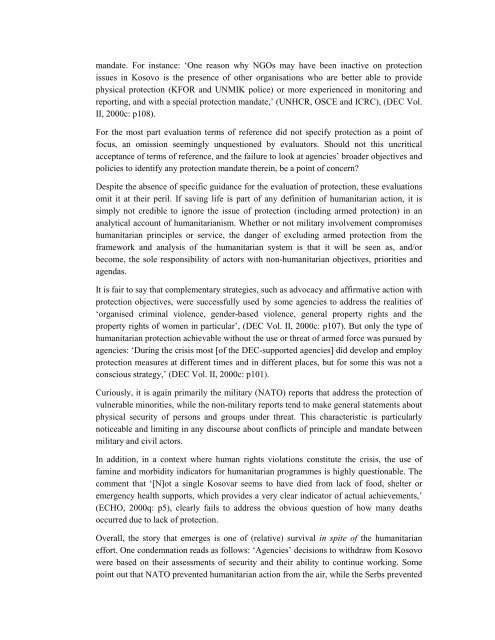Download PDF - ReliefWeb
Download PDF - ReliefWeb
Download PDF - ReliefWeb
Create successful ePaper yourself
Turn your PDF publications into a flip-book with our unique Google optimized e-Paper software.
mandate. For instance: ‘One reason why NGOs may have been inactive on protection<br />
issues in Kosovo is the presence of other organisations who are better able to provide<br />
physical protection (KFOR and UNMIK police) or more experienced in monitoring and<br />
reporting, and with a special protection mandate,’ (UNHCR, OSCE and ICRC), (DEC Vol.<br />
II, 2000c: p108).<br />
For the most part evaluation terms of reference did not specify protection as a point of<br />
focus, an omission seemingly unquestioned by evaluators. Should not this uncritical<br />
acceptance of terms of reference, and the failure to look at agencies’ broader objectives and<br />
policies to identify any protection mandate therein, be a point of concern?<br />
Despite the absence of specific guidance for the evaluation of protection, these evaluations<br />
omit it at their peril. If saving life is part of any definition of humanitarian action, it is<br />
simply not credible to ignore the issue of protection (including armed protection) in an<br />
analytical account of humanitarianism. Whether or not military involvement compromises<br />
humanitarian principles or service, the danger of excluding armed protection from the<br />
framework and analysis of the humanitarian system is that it will be seen as, and/or<br />
become, the sole responsibility of actors with non-humanitarian objectives, priorities and<br />
agendas.<br />
It is fair to say that complementary strategies, such as advocacy and affirmative action with<br />
protection objectives, were successfully used by some agencies to address the realities of<br />
‘organised criminal violence, gender-based violence, general property rights and the<br />
property rights of women in particular’, (DEC Vol. II, 2000c: p107). But only the type of<br />
humanitarian protection achievable without the use or threat of armed force was pursued by<br />
agencies: ‘During the crisis most [of the DEC-supported agencies] did develop and employ<br />
protection measures at different times and in different places, but for some this was not a<br />
conscious strategy,’ (DEC Vol. II, 2000c: p101).<br />
Curiously, it is again primarily the military (NATO) reports that address the protection of<br />
vulnerable minorities, while the non-military reports tend to make general statements about<br />
physical security of persons and groups under threat. This characteristic is particularly<br />
noticeable and limiting in any discourse about conflicts of principle and mandate between<br />
military and civil actors.<br />
In addition, in a context where human rights violations constitute the crisis, the use of<br />
famine and morbidity indicators for humanitarian programmes is highly questionable. The<br />
comment that ‘[N]ot a single Kosovar seems to have died from lack of food, shelter or<br />
emergency health supports, which provides a very clear indicator of actual achievements,’<br />
(ECHO, 2000q: p5), clearly fails to address the obvious question of how many deaths<br />
occurred due to lack of protection.<br />
Overall, the story that emerges is one of (relative) survival in spite of the humanitarian<br />
effort. One condemnation reads as follows: ‘Agencies’ decisions to withdraw from Kosovo<br />
were based on their assessments of security and their ability to continue working. Some<br />
point out that NATO prevented humanitarian action from the air, while the Serbs prevented
















![CynefinFramework final [Read-Only]](https://img.yumpu.com/19017304/1/190x135/cynefinframework-final-read-only.jpg?quality=85)